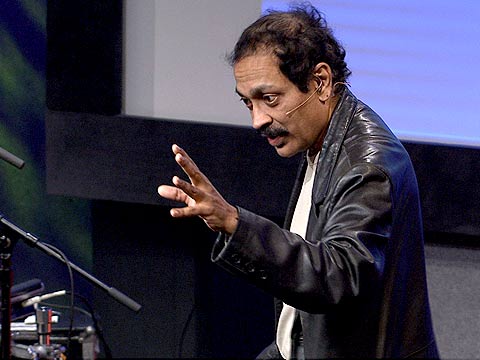

V.S. Ramachandran is a man who looks into brains.
He adds to our view on human nature and human consciousness.
As a neuroscientist he is known primarily for his work in the fields of behavioral neurology and visual psychophysics.
As a speaker he has the great ability to concretely and simply describe the most complicated inner workings of the brain.
When Ramachandran looks into the brain he does so with patients with sustained damage to a small region of the brain. Such a condition created a sort of blunting of their cognitive ability while other functions are preserved intact.
Imposter? – Wired
One of these very rare syndromes is the Capgras delusion, a person suffering from this delusion can recognize the face of a person but will assume that it is not the person he or she recognizes but an imposter.
The reason for this disorder is a lack of connection to emotions. Our brain has areas just concerned with vision, after processing that it forwards the information to an area where we perceive faces. From there the message cascades into the amygdala to continue down the autonomic nervous system.
The amygdala in the limbic system is the emotional core of the brain. It is there to gauge the emotional significance of what you’re looking at. Now, when the connection to the emotional centers is cut, the person recognizing a face will lack the emotional feeling it usually connects with this face. It is because of this lack of emotion that the person will assume that even if he recognizes the face it is not the person he recognized but an imposter.
The pathway going from the hearing centers in the brain to the emotional centers is a different one and might be still ok, in such a case, if the patient calls the same person via the phone there will be no delusion and he will recognize the voice and the person.
Bouba Kiki – Cross Wired
After looking at wired connections, Ramachandran describes some cross wired connections known as synesthesia. For this he uses the Bouba Kiki effect. Being presented with two different shapes, one more rounded and one jagged a vast majority will attribute the name Kiki to the jagged shape and Bouba to the other one. The brain is somehow capable to extract the common denominator between the visual inflection and the auditory pattern. It is a primitive form of abstraction which is happens in the face area of the brain (fusiform gyrus). When this area is damaged people lose their ability to engage in Bouba Kiki as well as the ability to engage in metaphor.
What does this say?
Hearing, vision and touch have their own pathways to emotions. We also have the ability to associate information between these. On the other hand if one of them is missing, it is difficult for us to create the right association. When information is missing our view of the situation might be changed (i.e. the person is not the person I see) thus leading into erroneous interpretations.
Sure, this is not really new and doesn’t need to be. The result of such research just helps to understand existing theories, making them more accessible.
Hear more about this research from V.S. Ramachandran himself in his In his TED Talk “3 clues to understanding your brain”.


[Original publication via frogstalk.com, Mai 26, 2014]
